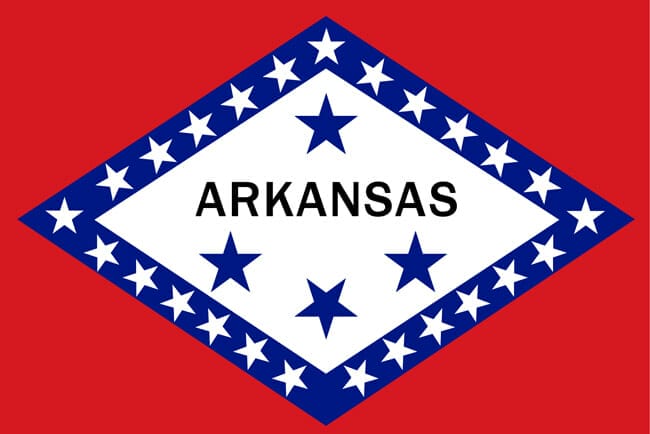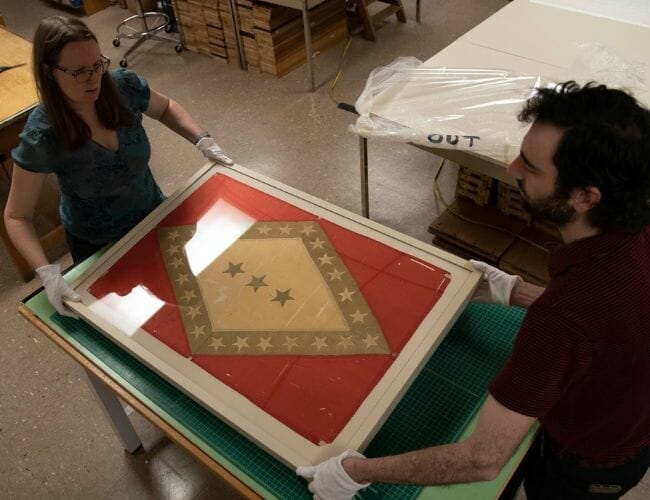

Uh oh...
It appears that you're using a severely outdated version of Safari on Windows. Many features won't work correctly, and functionality can't be guaranteed. Please try viewing this website in Edge, Mozilla, Chrome, or another modern browser. Sorry for any inconvenience this may have caused!
Read More about this safari issue.

On June 14, Flag Day commemorates the 1777 official adoption of the Stars and Stripes flag design to represent the United States of America. And while the Arkansas state flag did not come to be until 1913, it holds a similar symbolism in design and meaning.
U.S.S. Arkansas, a dreadnought battleship used in both world wars, was to be commissioned in 1912. Straight from a New York Shipyard and already in the waters, the Pine Bluff chapter of the Daughters of the American Revolution (DAR) wanted to ceremoniously present a “stand of colors,” including an Arkansas state flag. Accordingly, three women submitted a request to Secretary of State Earl W. Hodges for an official state flag to complete their plan.
They swiftly received a response, “There is not one.”
With this information, the Pine Bluff DAR chapter determined to conduct a statewide design process for an official Arkansas state flag. Sixty-five entries came in from all over the state, including crayon drawings, miniature silk examples and watercolor sketches.

Making a selection
Secretary of State Hodges served as the selection committee chair and surrounded himself with a distinguished group of decision-makers.
- Dr. Junius Jordan, the chairperson of philosophy and pedagogy at the University of Arkansas
- Mrs. Julia McAlmont Noel, a member of the John McAlmont Chapter of the DAR in Pine Bluff
- Miss Julia Warner, a teacher in the Little Rock school system
- Mrs. P. H. Ellsworth, a former Arkansas Federation of Women’s Club president
The committee gathered in the early days of 1913 and chose a design by Miss Willie Hocker, a Pine Bluff DAR chapter member.

Arkansas’ Secretary of State’s Office records the following about Miss Hocker’s design:
On a red rectangular field, Miss Hocker placed a large white diamond bordered by 25 white stars on a blue band. Three blue stars in a straight line were centered in the diamond.
Miss Hocker explained that the colors in her design meant that Arkansas was one of the United States of America. The three blue stars had three meanings: Arkansas belonged to three countries (France, Spain and the United States) before attaining statehood; 1803 was the year of the Louisiana Purchase when the land that is now the United States acquired Arkansas; and Arkansas was the third state created from the purchase by the United States, after Louisiana and Missouri.
The 25 stars mean Arkansas was the 25th state to be admitted to the Union. The diamond represents Arkansas as the nation’s first diamond-producing state. The two parallel white stars at the diamond’s left and right points symbolize Arkansas and Michigan’s dual admission to the Union.

Who is Willie K. Hocker?
Willie Kavanaugh Hocker was born in Kentucky, the youngest child of William Kavanaugh, a Civil War veteran and Virginia Brown. The Hockers moved to Arkansas in 1870 to a plantation in the Dudley Lake Township in Jefferson County.
Willie attended local schools in Pine Bluff and Kentucky and obtained a teaching certificate from the University of Colorado at Boulder.
Miss Hocker was visiting friends in Pine Bluff when she drew her winning submission. In true form, for a public school teacher, her drawing was submitted on school drawing paper using watercolors.
Miss Hocker was a poet and taught school in Pine Bluff and Jefferson County for 34 years, always emphasizing Arkansas History. She remained a member of the Pine Bluff Chapter of D.A.R. and other civic and societal groups, like the United Daughters of the Confederacy and the Colonial Dames Society.
Willie Hocker is the only woman, besides Betsy Ross, the designer of the U.S. flag, to have her design represent a state.
Becoming Official
In February 1913, the state Legislature official voted on the design for the Arkansas state flag. Over time the star notations changed in the middle to represent Arkansas’s participation in the Confederate States of America from 1861-1865. Finally, in 1924, the new design was adopted where the star above “Arkansas” represents the Confederacy’s participation, and the three stars below stay true to Hocker’s original design concepts.
While many of the other submissions included Arkansas state symbols like apple blossoms scattered around, the state seal, farming tools or 13 rays of color, this design linked Arkansas to the United States of America in such a direct way. These connections include the stars and stripes, capturing the symbolism of the 24 states to come before us and matching the patriotic red, white and blue.
I Salute the Arkansas Flag With Its Diamond and Stars. We Pledge Our Loyalty to Thee.”

Fun facts about the Arkansas State Flag:
- The original committee made one change to Hocker’s original design and added the state name to the flag and rearranged the three stars.
- The flag was first presented to Arkansans at Oaklawn Park in Hot Springs at the 1913 Arkansas State Fair.
- The 65 submissions came in a second call for entries. The first request by the DAR chapter and Secretary of State received no response.
- Virginia Belcher Brock, a daughter of Arkansas pioneers, wrote the state pledge.
- In 2011, Governor Mike Beebe signed a law that the flag’s official colors would match “old glory red” and “old glory blue” and must all be American-made.

- In 2018, the original flags underwent historical renovations to preserve the thinning fabric and tears and are part of the permanent collection at the Arkansas State Archives.
- Annin, the oldest American flag company, makes Arkansas’ official state flags.
- A lapel pin bearing a replica of the Arkansas Flag should be worn only on the left lapel near the heart.
- When the flag’s condition is no longer fit for display, it should be disposed of like the U.S. Flag. Find details for flag disposal near you.
- In 2013, on the 100th anniversary of the Arkansas Flag, a commemoration ceremony was held to honor Hocker and open the Arkansas State Flag Memorial in Wabbaseka.
Cover image used with permission from Arkansas Department of Parks, Heritage and Tourism.
We do the work.
You check your email.
Sign up for our weekly e-news.
Get stories sent straight to your inbox!









Like this story? Read more from Keisha Pittman McKinney
The Dierks High School win in the Friday Night 5G Lights competition has...
New Year’s Eve looks different for everyone. Some people love to dress...
There is nothing quite like Helena, Arkansas, when it comes to a...
Join the Conversation
Leave a Comment